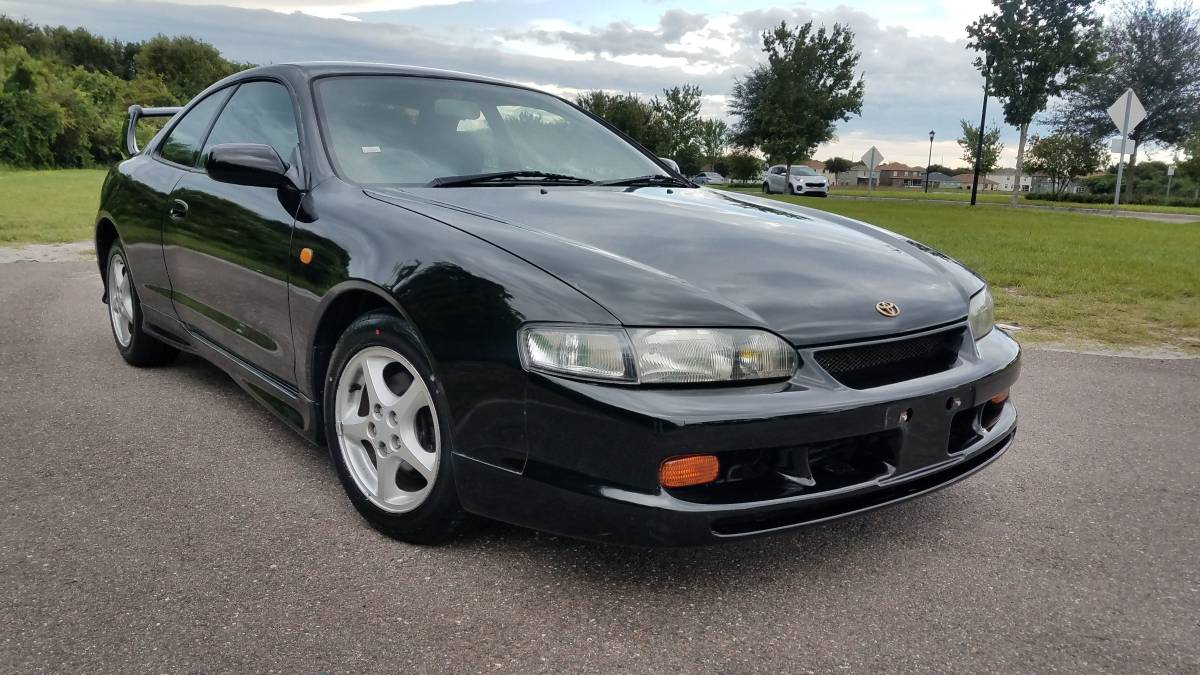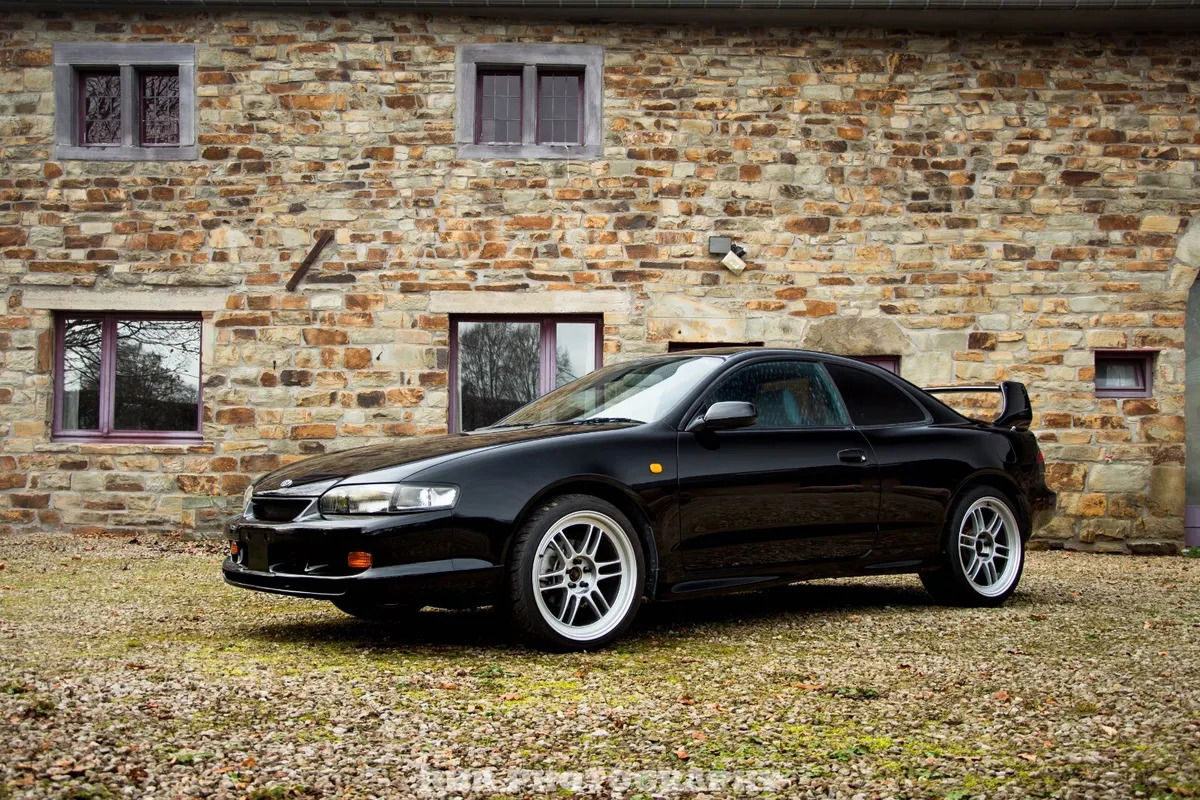The Toyota Curren was a sports coupe produced by Toyota Motor Corporation in Japan from 1994 to 1998. It is essentially a two-door version of the Toyota Celica with which it shared many components, albeit with a unique body styling.
The Curren offered a more luxurious alternative to the Celica, targeting customers who were looking for a sporty coupe with a bit more elegance and comfort. Underneath, the Curren utilized the same platform as the sixth-generation Celica (ST200 series), with its propulsion power coming from a variety of inline 4-cylinder engines, including some with Toyota's Variable Valve Timing (VVT) technology.
If you’re hearing about the Curren for the first time today, you’re not the only one. It was sold exclusively in the Japanese domestic market (JDM), making it relatively rare and less known outside of Japan. It didn't get a mass-market version, like the Supra or Nissan Skyline, for oversea sales.
Since production ended in the late '90s, the Curren is not as commonly discussed or recognized as some of Toyota's other sports cars from that era, like the Supra or MR2, but it remains a "lost" part of Toyota's legacy in niche-market sporty coupes.
See also:
A Closer Look Back At 5 Best Performance Cars From The 1990s
So, Is The Curren The Same As The Celica?

Photo credit: Tennen-gas via Wikimedia
The Toyota Celica was a popular sports car and coupe model produced over seven generations from 1970 to 2006, with each generation introducing various updates and changes to the design and technology. The Toyota Curren, on the other hand, was produced for a shorter period compared to the Celica.
Toyota produced the Curren from 1994 to 1998 as a limited production model based on the sixth-generation Toyota Celica platform. Drawing inspiration from the renowned T200 series Celica chassis, the Curren introduced a unique blend of style and functionality.
While inheriting the Celica coupe's interior and rear-end design, the Curren stood out with a rectangular headlamp configuration creating a classic halogen appearance.
This styling tweak didn't just promote its visual appeal but also enabled Toyota to market the Curren at the marque’s Toyota Vista Store outlets, providing a fresh alternative to the Celica's exclusive availability at Corolla Store locations.
Boldly stepping into the shoes of its predecessor (the T160 series Corona Coupe), which was formerly exclusive to Toyopet Store venues, the Curren lived up to its name as a "current (trendy)" sports car of its time.
Both the Celica and Curren have their places in Toyota's history of producing fun-to-drive sports cars, with the Celica being more widely recognized and produced over a longer period compared to the Curren.
Why Is The Curren Not As Popular As Toyota's Other Sports Cars From The 1990s?

1996 Toyota Curren XT206 - Photo credit: Qurren via Wikimedia
We can count four reasons why the Toyota Curren is not as well-known as some other '90s gems like the Supra, MR2, and the Celica.
First of all, the Toyota Curren was a JDM, which means it was primarily sold in the Japanese domestic market. This means fewer people outside Japan are familiar with the Curren compared to celebrities like the Supra, which were sold in more markets worldwide.
Secondly, Toyota positioned the Curren as a more upscale alternative to the Celica, targeting a slightly different and smaller market segment.
More so, Curren's unique styling and convenience features (including a TV), tailored to this unique market, made it less appealing to hardcore sports car enthusiasts who preferred the more performance-oriented offerings like the Supra and MR2.

1996 Toyota Curren XS 4AT interior
Thirdly, let's not forget that the Curren had a relatively short production run spanning just a few years from 1994 to 1998. Consequently, there are fewer Curren models out there today compared to other Toyota sports cars from the 1990s.
Finally, we know that auto journos and the media found little to write home about the Curren back then, just because the design and performance characteristics were not as distinctive or groundbreaking.
While the Curren shared some components with the Celica, one can see how pundits would've had much higher expectations from a Celica spinoff. As a result, the Curren failed to garner well-deserved love and acclaim from automotive enthusiasts and the media.
The Toyota Curren's Powertrain And Performance

3S-FE engine on Toyota Curren XS 4AT (2006) - Photo credit: Qurren via Wikimedia
The Toyota Curren featured a range of engine options and drivetrains during its production years from 1994 to 1998. They include:
- 3S-FE: 2.0L inline-4 engine 3S-FE engine on Toyota Curren XS 4AT (2006). with DOHC producing around 130 horsepower.
- 3S-GE: 2.0L inline-4 engine with DOHC and VVT producing around 170 horsepower (used in the GT-Z trim level).
The Curren used a front-wheel-drive drivetrain, so the engines routed power to the front wheels via a 5-speed manual transmission or a 4-speed automatic transmission. The 2.0L 3S-GE engine was capable of achieving 0-60 mph in around 8-9 seconds, all factors considered.
The base 2.0L 3S-FE engine produced around 130 horsepower, while the higher-performance 2.0L 3S-GE engine in the GT-Z trim level produced around 170 horsepower.
Torque figures for these engines varied but typically ranged from around 133 lb-ft for the 3S-FE to around 147 lb-ft for the 3S-GE.
A Look Back At The Classic Charm Of The 1997 Suzuki Sidekick JX Sport
A Closer Look Back At The Toyota Curren Model Years

1995 Toyota Curren - Photo credit: GuysWithRides.com
In 1994, Toyota unveiled the Curren with two variants: the ST206 and ST207. The ST206 offered four trim levels: FS, XS, ZS, and ZS Sport Selection, powered by either a 138-hp 2.0-liter 3S-FE engine or a 168–177-hp 2.0-liter 3S-GE engine for ZS trims.
The ST207 featured only the XS Touring Selection trim with a 3S-FE engine, 4-wheel steering, and (as some say) Toyota's TACS suspension. In 1995, Toyota introduced the XS and ZS S-Package trims with added features like a rear spoiler and alloy wheels.
The later ST208 model offered TS and TS Private Selection trims, both powered by a 123-hp 1.8-liter 4S-FE engine. In 1996, the Curren received a facelift with redesigned bumpers, taillamps, and grille. The taillamps now had clear turn signals, contrasting the previous orange ones.
By 1997, the four-wheel steering ST207 was phased out, and production ceased in July 1998, with 42,000 units sold. Notably, Toyota launched the TRD Sports version in late 1995, limited to 300 units for the Japanese market.
It featured interior and exterior modifications, including a TRD muffler, rear wing, front bumper, leather shift knob, and TRDSPORTS steering wheel.
The TRD Sports Curren offered a 5-speed manual with LSD or 4-speed automatic transmission, with the manual having a helical limited-slip differential as standard.
Why You Want The Curren

1996 Toyota Curren - Photo credit: Jones028 via Wikimedia
Three words: 4WS and Superstrut suspension.
Naturally, the sort of blokes drawn to this car are gearheads, so it’s safe to say you want to go for the ST207 generation produced until 1997. They featured 4-wheel steering combined with an advanced Superstrut suspension system.
There were talks of certain versions of the Curren featuring Toyota’s Active Control Suspension (TACS), but this claim is yet to be substantiated.
Toyota's TACS system adjusts shock absorber damping forces in response to road conditions and driving dynamics to improve ride comfort and handling. What we do know is that the ST207 Curren benefited from Toyota’s Superstruts, which is essentially a blend of MacPherson and multilink.
Equipping the Curren with 4-wheel steering and Superstrut suspension had significant implications for the car's performance, handling, and overall driving dynamics.
As you know, 4-wheel steering, also known as rear-wheel steering, allows the rear wheels to turn in conjunction with the front wheels. This feature enhances the car's agility, maneuverability, and stability during low-speed maneuvers and high-speed cornering.
At low speeds, the rear wheels turning in the opposite direction to the front wheels reduces the car's turning radius, making it easier to navigate tight spaces and parking lots.
At higher speeds, the rear wheels turning in the same direction as the front wheels improves stability and handling while reducing understeer during cornering. Blending this with an advanced suspension system is a recipe for fun-to-drive engineering.
The Superstrut suspension system is an advanced type of suspension design that aims to reduce torque steer and enhance traction by minimizing the negative effects of front-wheel-drive layouts. That means minimized body roll during cornering.
By reducing unwanted suspension movement and maintaining better tire contact with the road surface, the Superstrut suspension enhances grip, traction, and overall performance in various driving conditions.
The advanced Superstrut suspension system can also contribute to improved steering response, better road feel, and increased comfort for the driver and passengers.
The Curren TRD

Photo credit: eBay
The 1995 Toyota Curren TRD Sports is a rare and unique model of the Toyota Curren lineup. The TRD Sports was based on the T200 series Celica chassis and shares the same interior and rear-end design as the Celica coupe.
The Toyota Curren TRD Sports features a 2-door coupe body style with a front-engine, front-wheel-drive layout. It is equipped with various engine options, including a 1.8L 4S-FE I4, a 2.0L 3S-FE I4, and a 2.0L 3S-GE I4, producing power ranging from 123hp to 177hp.
The transmission options include a 5-speed manual or a 4-speed automatic. Of course, what made the Toyota Curren TRD Sports a TRD Sports is its TRD Sports package, which brought enhancements like a TRD rear spoiler, fender spats, front bumper, turn signals, steering wheel, and carbon-fiber interior trim.
If you thought the Curren is a rare JDM, you can imagine what the 300-unit TRD Sports is. Additionally, optional upgrades such as TOM'S Racing wheels, shifters, and decals were available as dealer options.
Why Toyota Stopped Making The Curren

1995 Toyota Curren - Photo credit: GuysWithRides.Com
Toyota decided to let the Curren die a quiet death until a new generation is introduced, instead of propping up the vehicle with incentives. Killing the Curren was due to market conditions and the segment the vehicle was in. The Curren did not achieve the level of sales success that Toyota had hoped for.
The model was positioned as a more upscale and luxurious alternative to the Celica, but it failed to resonate strongly with its target market or garner enough demand to justify its continued production.
More so, the automotive market was becoming increasingly competitive as new models entered the sports coupe segment.
Additionally, automakers often review their model lineup to streamline production and focus on more popular, profitable models. So, it makes sense that Toyota decided to discontinue the Curren to allocate resources to other models that were performing better in the market.
By the late 1990s, automotive design trends and technology were evolving rapidly. A forward-thinking company like Toyota would shift its focus to developing new models with the latest design elements, features, and technology.
This would put the Curren, in its current form, at a disadvantage as it was based on an older platform. Considering that Curren was exclusive to the Japanese domestic market, Toyota prioritized models with broader global appeal and market potential.
Toyota Curren For Sale

Silver Curren for sale on JDMExport
Looking to buy the Curren? There’s good news and bad news. The good news is the Curren is old enough to be imported legally to the United States. The bad news is the Curren is so rare that we found just one for sale at JDMExport, as at press time.
It’s advertised as a 1995 Toyota Curren with less than 60,000 miles and featuring power steering, power windows, and a manual transmission paired with the 2,000cc engine. This model belongs in the ST200 generation, which means it doesn’t have the 4-wheel steering. The car is advertised at $8,671, but the buyer will pay $11,446 in total, including ocean freight to your selected sea port.